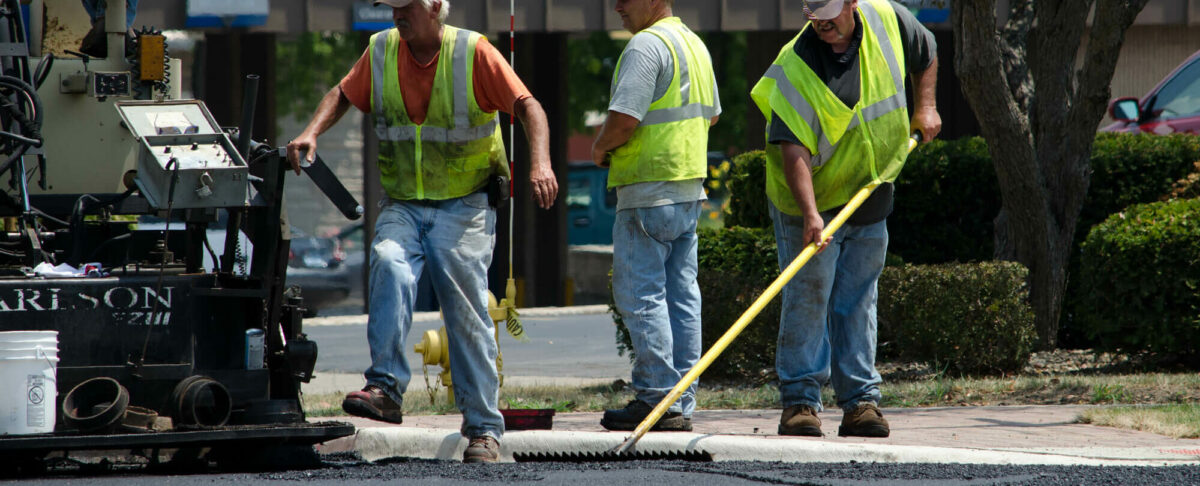When you think about sustainability, the first thing that comes to mind is probably planting trees or recycling, not asphalt, and especially not infrared asphalt repair. That’s okay. You’re not alone in this train of thought. Nonetheless, asphalt is known as ‘the eco-friendly pavement. It’s actually the most recycled material in North America. With this in mind, it makes sense that asphalt is used in a green process to repair pavement that saves time and money called infrared asphalt repair.
What is it about this asphalt restoration process that makes it a sustainable option for commercial and residential pavement repairs? What is infrared asphalt repair in the first place, and how does it work? If you’re seeking answers to these questions, you’ve come to the right place.
To see this process in action, watch the video below showing how we get the job done at Richfield Blacktop.
Infrared Asphalt Repair: What is it?
Infrared asphalt repair, or IRR, is a fairly simple technique used to repair road damage, among other applications. The infrared process requires an infrared heater to warm the damaged asphalt to a malleable state, then new asphalt is added, and the two combine seamlessly. To fully understand the process, follow our step-by-step guide:
- The area around the damaged asphalt is swept clean and dried out. There can’t be any debris or moisture blocking the infrared heat from reaching the asphalt surface.
- The infrared heater warms the damaged area until it reaches 325-350 degrees Fahrenheit. The time it takes to reach this temperature can vary depending on the weather and the degree of damage.
- After the heating process, the damaged area is raked to remove loose and failed asphalt aggregate.
- A rejuvenating substance is added to the remaining aggregate to replenish oils lost over time.
- Now the new asphalt is added to combine with the old. The asphalt must be graded to the correct level.
- The asphalt mixture is complete, and a machine roller compacts the previously damaged area to produce a seamless patch.
When Can IRR Be Done?
One of the most unique and attractive things about IRR is that it can be done all year long. It is the only repair treatment that can be performed on the hottest, most humid summer day, as well as the most frigid winter day.
Because IRR can be implemented at any time of the year, it remains the most cost-effective way to repair asphalt year-round. Unlike traditional asphalt repair methods, IRR requires no extra machinery to maintain the asphalt temperature, no matter how cold the climate is.
How is Infrared Asphalt Repair Sustainable?
Infrared Asphalt Repair is sustainable for two reasons:
- Instead of removing and throwing away the original asphalt patch, the material is almost entirely recycled on the spot.
- IRR requires far less power and machinery than other asphalt repair methods.
Before IRR, some asphalt repair companies sent several tons of asphalt per day away to be put through the asphalt recycling process. Thanks to IRR, these companies can go to a job site, use minimal new asphalt, and scrap minimal old asphalt. Furthermore, when IRR is used to fix a pothole, it takes less than half an hour and requires:
- One infrared heater
- One truck
- Two workers
Pothole repair using the cut-and-remove method can take several hours and requires:
- One pavement saw
- One jackhammer
- One bucket loader
- Two trucks
- Enough new asphalt to replace all of the old asphalt
- A whole team of workers
As you can see, in just this one scenario, IRR recycles a significant amount of asphalt right away and requires far less machinery, labor, time, and money.
Is IRR Always the Right Solution?
Unfortunately, infrared asphalt repair is not always the best solution. IRR is a surface repair solution. If there are deeper structural or base problems and the asphalt’s subsurface is no longer recoverable, this type of repair on a damaged subsurface won’t fix the issue. It may temporarily prevent the current damage from getting worse, and repair will likely be needed within one to two years. While IRR has the potential to do a lot of good, it’s not perfect; it has some downsides.
Commercial and Residential Uses for IRR
This process of Infrared Asphalt Repair may sound foreign to you, but I guarantee you’ve seen it at least once. The number one use of IRR is to repair those pesky potholes that pop up every winter and spring. Although the infrared pothole repair process is the most common use of IRR, it actually has many other commercial and residential uses.
Commercial Asphalt Repair
There are many benefits of using IRR when it comes to commercial asphalt repairs, like cost and time. The commercial uses for IRR include, but are not limited to:
- Parking lot speed bumps
- Pothole repair
- Create patterns in the asphalt
- General asphalt damage like divots, cracks, heaving
Residential Asphalt Repair
The residential applications for IRR are more limited than the commercial applications, but there are still many ways to use it, such as:
- Birdbath removal
- Lower high spots
- Repair catch basins
- Driveway repair
Asphalt Repair Specialists
Whether your needs are residential or commercial, if you’re looking for a sustainable way to repair surface-level asphalt damage, IRR is the solution you’ve been looking for. As your trusted local asphalt contractor since 1954, Richfield Blacktop provides the highest quality infrared asphalt repair services, as well as a host of other pavement services. We care about our customers and the work we do, which is why we offer warranties, protection plans, and top-notch customer service. Contact us today to learn what we can do for you.





